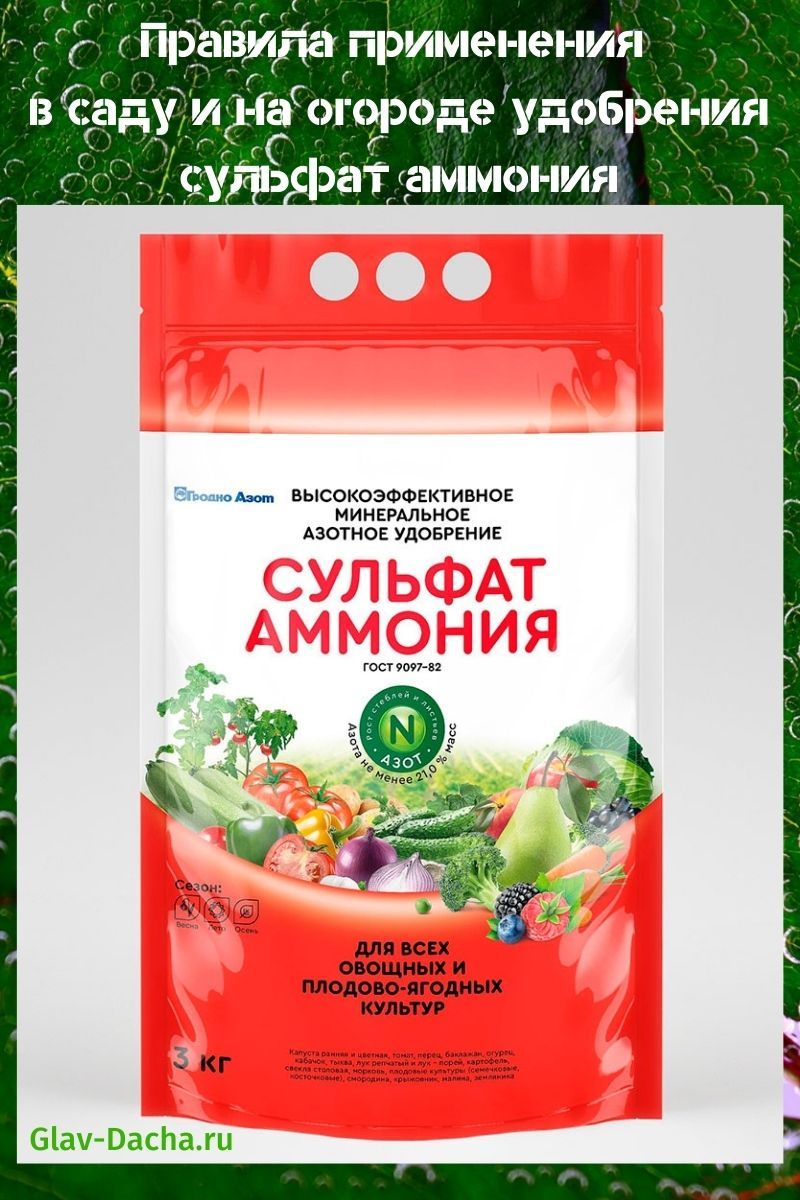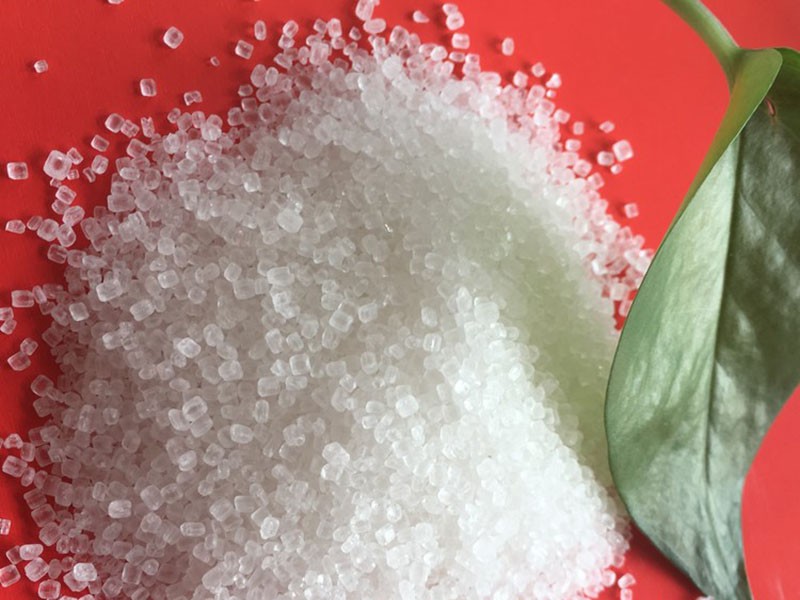Rules for use in the garden and in the garden fertilizer ammonium sulfate
 Fertilizer ammonium sulfate or ammonium sulfate is one of the most popular and effective means for increasing yields. Such feeding is most valuable in spring. It completely compensates for the lack of nitrogen and sulfur in vegetable, garden and ornamental plants, ensuring their rapid and proper development, as well as excellent taste of the fruit.
Fertilizer ammonium sulfate or ammonium sulfate is one of the most popular and effective means for increasing yields. Such feeding is most valuable in spring. It completely compensates for the lack of nitrogen and sulfur in vegetable, garden and ornamental plants, ensuring their rapid and proper development, as well as excellent taste of the fruit.
What is ammonium sulfate


FROMthe content of the active ingredient in ammonium sulfate:
- nitrogen - 21%;
- sulfur - 24.

The active substances are presented in the form of ions, due to which they are completely absorbed by plants. In the agricultural field, ammonium sulfate is classified as a nitrogen fertilizer.
 Ammonium sulfate is produced in the form of transparent crystals that can have a slight grayish or yellow tint. At a heating temperature above + 100 ° C, it begins to decompose into its constituent components.
Ammonium sulfate is produced in the form of transparent crystals that can have a slight grayish or yellow tint. At a heating temperature above + 100 ° C, it begins to decompose into its constituent components.
The solubility of ammonium sulfate in water depends on its temperature. At 100 ° С - 100 g / 100 g, at 25 ° С 77 g / 100 g dissolve, at 0 ° С only 70 g / 100 g.
Useful properties of ammonium sulfate
 The fertilizer ammonium sulphate contains two active substances necessary for vegetable, horticultural and ornamental crops - nitrogen and sulfur.
The fertilizer ammonium sulphate contains two active substances necessary for vegetable, horticultural and ornamental crops - nitrogen and sulfur.
Nitrogen is presented in ammonium form, due to which it is quickly absorbed by plants, strengthens their immunity and accelerates growth. Sulfur promotes the maximum assimilation of nitrogen and other microelements, improves cell metabolism, increases plant resistance to diseases and adverse weather conditions.
What is ammonium sulfate for in the garden:
- regulation of cellular processes in plants necessary for development and fruiting;
- improved juiciness and taste of fruits;
- increasing the content of oils in oilseeds (rapeseed and sunflower);
- strengthening immunity to disease;
- increased frost and drought resistance;
- improvement of keeping quality of fruits.
For the application of fertilizer, ammonium sulfate can be applied to the soil both in the form of granules and in liquid dressings.
Fertilizer advantages and disadvantages
 The use of ammonium sulfate has become widespread among gardeners and gardeners due to the many advantages over other dressings.
The use of ammonium sulfate has become widespread among gardeners and gardeners due to the many advantages over other dressings.
The main benefits of ammonium sulfate:
- does not get damp and does not cake during long-term storage;
- persists in the soil for a long time, is not washed out by rains and groundwater;
- provides long-term storage of the harvested crop;
- goes well with other dressings;
- does not have a toxic effect on plants, people, animals and beneficial insects;
- does not lead to the accumulation of nitrates in the fruit;
- has a low cost.
 But ammonium sulfate fertilizer has several disadvantages as well. If the dosage is exceeded, the substance can cause acidification of the soil. That is why, most often, top dressing requires liming the soil. In addition, ammonium sulfate will not help in the fight against insect pests, since it does not have insecticidal and fungicidal properties.
But ammonium sulfate fertilizer has several disadvantages as well. If the dosage is exceeded, the substance can cause acidification of the soil. That is why, most often, top dressing requires liming the soil. In addition, ammonium sulfate will not help in the fight against insect pests, since it does not have insecticidal and fungicidal properties.
When is it better to add ammonium sulfate
 Ammonium sulfate is used all year round, but it is most commonly used in the spring. Top dressing is applied 20-25 days before sowing, when digging a site. It saturates the soil with nitrogen and sulfur, improving the growth and fruiting of plants.
Ammonium sulfate is used all year round, but it is most commonly used in the spring. Top dressing is applied 20-25 days before sowing, when digging a site. It saturates the soil with nitrogen and sulfur, improving the growth and fruiting of plants.
Ammonium sulphate can be added in the fall. It remains in the soil for a long time, so in the spring it will not need fertilizers. This will save time before sowing.
 But it must be borne in mind that such an autumn dressing cannot be used for perennial crops. This stimulates the growth of young shoots, which freeze in winter, die, weakening the plant.
But it must be borne in mind that such an autumn dressing cannot be used for perennial crops. This stimulates the growth of young shoots, which freeze in winter, die, weakening the plant.
Use on various types of soil
 When using ammonium sulfate as a fertilizer, it is necessary to take into account the acidity of the soil, since this substance can increase it. That is why application on acidic soils is undesirable. If ammonium sulfate is still used, it must be combined with lime - 130 g for every 100 g of fertilizer.
When using ammonium sulfate as a fertilizer, it is necessary to take into account the acidity of the soil, since this substance can increase it. That is why application on acidic soils is undesirable. If ammonium sulfate is still used, it must be combined with lime - 130 g for every 100 g of fertilizer.
Ammonium sulphate is excellent for feeding black soil and soils rich in humus. It does not disturb the acid-base balance, maintaining the high fertile qualities of the soil.
When using fertilizer on clay and loamy soil, difficulties may arise, since they are characterized by high moisture content and density. In this case, before applying top dressing, the area must be drained and loosened.
Fertilizer ammonium sulfate - instructions for use
 Ammonium sulfate can be applied in dry form during digging of the site. Depending on the type of plants, the feeding dose is 35-45 g per sq. m. Also, the granules can be used in the form of a liquid solution for root and foliar dressing. The rate and method of using ammonium sulfate depends on the type of crops.
Ammonium sulfate can be applied in dry form during digging of the site. Depending on the type of plants, the feeding dose is 35-45 g per sq. m. Also, the granules can be used in the form of a liquid solution for root and foliar dressing. The rate and method of using ammonium sulfate depends on the type of crops.
For potatoes and root vegetables
 Ammonium sulfate for potatoes is not only an excellent source of nitrogen, but also protection against scab, rot and other diseases. In addition, top dressing increases the amount of starch in fruits, improving their taste.
Ammonium sulfate for potatoes is not only an excellent source of nitrogen, but also protection against scab, rot and other diseases. In addition, top dressing increases the amount of starch in fruits, improving their taste.
Dosage for potatoes and other vegetables:
- Potatoes - most often top dressing is applied dry, in a dosage of 35-40 g per 1 sq. m.
- Carrots - granules are applied at 20-25 g per 1 sq. m.
- Beets - this root crop requires 30-40 g per 1 sq. m.
When using the fertilizer ammonium sulfate, you need to additionally spray the potato beds from wireworms, Colorado beetles and beetles. Ammonium sulfate does not accumulate in roots and does not lead to high nitrate concentrations.
For cabbage
 Ammonium sulfate is used to feed different types of cabbage - white cabbage, red cabbage, Brussels sprouts, cauliflower, broccoli and kohlrabi.
Ammonium sulfate is used to feed different types of cabbage - white cabbage, red cabbage, Brussels sprouts, cauliflower, broccoli and kohlrabi.
Fertilizer dosage for different types of cabbage per sq. m:
- white cabbage - 55-60 g;
- red head - 70 g;
- color - 35 g;
- Brussels - 50-55 g;
- broccoli and kohlrabi - 45 g.
When using ammonium sulfate for cabbage, you must strictly adhere to the dosage. Too much nitrogenous fertilizing will cause the green mass to grow rapidly. In this case, the heads of cabbage will not be tied up or will be small, and the cauliflower will begin to "stretch".
Ammonium sulfate for cabbage is best applied during digging of the soil before planting seedlings or 7 days after planting.
For greenery
 Ammonium sulfate is a versatile fertilizer that can be used to grow dill, parsley, celery, thyme, peppermint, and basil. Nitrogen fertilization stimulates the growth of the green part of the plant.
Ammonium sulfate is a versatile fertilizer that can be used to grow dill, parsley, celery, thyme, peppermint, and basil. Nitrogen fertilization stimulates the growth of the green part of the plant.
Fertilizer application methods:
- in dry form - 15-20 g per 1 sq. m;
- in liquid form - 10 g of top dressing per 2 liters of water;
- top dressing of row spacings - 50-70 g.
Fertilizer ammonium sulfate can be used throughout the growing season. 15-20 days before harvesting, nitrogen fertilization must be stopped, otherwise nitrates will begin to accumulate in the greenery.
For fruit bushes
 Gardeners use ammonium sulfate to feed raspberries, strawberries, strawberries, gooseberries, blueberries and grapes.
Gardeners use ammonium sulfate to feed raspberries, strawberries, strawberries, gooseberries, blueberries and grapes.
When applying fertilizer, the following dosages are used:
- gooseberries, raspberries, grapes - 50-60 g;
- strawberries and strawberries - 45-50 g;
- currants - 40-50 g.
For feeding fruit shrubs, you can use a liquid solution prepared from 10 g of ammonium sulfate and 10 liters of water. Under each bush, 1 liter of the prepared solution is applied.
What can replace ammonium sulfate
 Ammonium sulfate is a source of nitrogen and sulfur, therefore, fertilizers containing these elements are selected for its analog. Most often, when choosing what to replace ammonium sulfate with, urea is chosen that has a similar composition.
Ammonium sulfate is a source of nitrogen and sulfur, therefore, fertilizers containing these elements are selected for its analog. Most often, when choosing what to replace ammonium sulfate with, urea is chosen that has a similar composition.
When replacing top dressing with urea, it must be borne in mind that these fertilizers have different chemical formulas. Therefore, you should familiarize yourself with the features of using each product, because ammonium sulfate contains not only nitrogen, but also sulfur. It is absent in the composition of urea.
Ammonium sulfate is an effective and affordable product that helps to get a rich harvest of vegetables, fruits, berries and grains. This is a universal fertilizer that strengthens the immunity of plants, ensures their active growth and good fruiting.